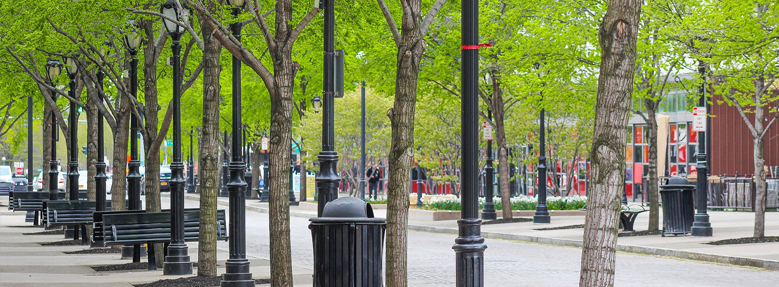Green infrastructure not only has 5 to 30 percent less upfront costs than traditional grey infrastructure, but it serves a variety of purposes, including decarbonization, aquifer recharging and flood mitigation. It is also 25 percent less expensive to maintain over its life cycle, and several Canadian cities have incorporated green infrastructure into their vision for the future.
Montreal has an ambitious urban forest plan, with a goal to increase tree cover to 25 percent by 2025 and plant 500,000 trees by 2030. Urban trees offer many benefits, including reducing urban heat islands; filtering ground water and reducing runoff; and sequestering greenhouse gases and filtering air pollution. Urban forests can reduce temperatures by 1 to 5 degrees Celsius, and in a nearly 20-year period, urban trees removed an average of 2.4 Mt of greenhouse gas per year.
Toronto has been a green infrastructure leader with its Green Roof Bylaw. The city encouraged the adaption of green roofs through an education program, incentives and streamlining approvals, along with requiring green roofs for new construction. The city has also incorporated an Eco-Roof Incentive Program that encourages the installation of green roofs and cool roofs, which have reflective surfaces. The incentive program offers $100 per square meter for green roofs and $2 to $5 per square meter for cool roofs. Additionally, the city offers $1,000 grants for qualifying applicants to determine whether their buildings are suitable for a green roof.
Much like urban forests, green roofs can lower temperatures, filter air and water pollution, absorb excess rainwater and reduce greenhouse gas emissions through reduced energy usage. Studies have shown that, while the installation of such a roof is more expensive than a conventional roof, a 1,951-square-meter roof would deliver more than $200,000 in savings through reduced heating and cooling costs, improved noise reduction and delayed roof replacement.
Wetlands can function in the same ways, absorbing carbon dioxide and water, while simultaneously filtering air and water pollutants. Wetlands also can recharge groundwater while offering recreational opportunities that can bring in revenue, such as fishing and hunting. After the 2013 Calgary flood, experts said that better maintenance of upstream wetlands would have mitigated the flooding. In response, Calgary established the River Flood Mitigation Program that leverages grey infrastructure, resilience measures and green infrastructure, and the Alberta provincial government released a new Wetland Policy to minimize the loss and degradation of wetlands.
Green Infrastructure isn’t as familiar or well understood as grey infrastructure, and, since it is not yet mainstream, the benefits may not be well known or immediately apparent. Because it is in the relatively early stages of adoption, many communities don’t have a municipal framework, including regulations; design specifications and standards; and permitting, in place. However, there is a growing network Canadian municipalities can look to for guidance, such as Montreal, Toronto and Calgary.
Municipalities also need to consider cost and logistics. Leveraging grey and green infrastructure to work in concert or complement each other can help bridge policy and integrate green infrastructure into the local economy and environment.
A $200 million Natural Infrastructure Fund was included in the federal budget in July, with $120 million over three years for cities, $20 million for large projects and the remaining $60 million for smaller projects. The federal budget also included another $1.4 billion in the Disaster Mitigation and Adaptation Fund over 12 years for wildlife mitigation activities and storm water system rehabilitation, with $670 million earmarked to small scale projects between $1 million and $20 million.
The Ontario provincial government has made $110 million available to municipalities, First Nation communities and Local Services Boards for green infrastructure, with a stated emphasis on clean drinking water. The Investing in Canada Infrastructure Program, a $33 billion, 10-year program which will be supported by federal, provincial and territorial governments, has earmarked more than $40 million for more than 70 green infrastructure projects through the first intake.
Municipalities can also consider offsets, where individuals or businesses can purchase credits to offset their greenhouse gas emissions, which the municipalities can then use to fund green infrastructure projects. The federal government is also considering a program to allow municipalities and landowners to register trees on their land for saleable carbon sequestration credits.
Municipalities might also require certain green infrastructure as part of new builds, such as requiring permeable sidewalks or a certain number of trees per square-foot of building space. Halifax has a stormwater credit program for non-residential buildings, which allows for a rebate of up to 50 percent of their water bill if they create a private stormwater management system, including green infrastructure.
Canadian cities have begun the move to green infrastructure because, not only does green infrastructure have benefits beyond water management and is more cost effective, but many stormwater drainage systems are reaching the end of their useable lifespans. Many stormwater systems face additional difficulties such as combined sewer overflows and deferred maintenance.
Maintenance isn’t only a problem for utilities, but also for homeowners, many of whom don’t even consider maintaining the service lines that connect them to their local utilities until there is a problem. Compounding the problem is that many homeowners aren’t aware that their service connections are their responsibility.
In the inaugural Service Line Warranties of Canada State of the Home survey, 25 percent of homeowners were unsure who was responsible, 20 percent believed their local municipality would be responsible, 18 percent thought the repair would be covered by homeowners’ insurance and 3 percent thought their utility was responsible. Unfortunately, most insurance policies don’t cover ordinary wear and tear of service lines unless the homeowner requests a special rider.
Service Line Warranties of Canada can help resolve that uncertainty. Not only do we provide educational materials, approved by our municipal partner, to alert homeowners of their service line responsibilities, but we also shield them from the financial shock of an unexpected repair with an optional service line warranty – more than 30 percent of homeowners surveyed had $500 or less set aside for an emergency home repair, and nearly 90 percent said municipalities should help educate them about their service line responsibilities.
Additionally, Service Line Warranties of Canada provides royalties that can be applied to everything from the general operating budget to green infrastructure programs.
Learn more about how we can help educate your residents by contacting us.

